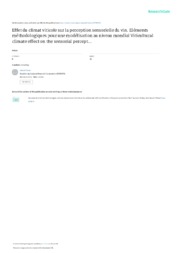Effect du climat viticole sur la perception sensorielle du vin. Eléments méthodologiques pour une modélisation au niveau mondial.
Effect du climat viticole sur la perception sensorielle du vin. Eléments méthodologiques pour une modélisation au niveau mondial.
Autoria: TONIETTO, J.; ZANUS, M. C.; GUERRA, C. C.
Resumo: The objective of this study was to develop a methodology capable of modeling the effect of viticultural climate on wine sensory characteristics. The climate was defined by the Géoviticulture Multicriteria Climatic Classification System (Tonietto and Carbonneau, 2004), based on the Heliothermal index (HI), Cool Night index (CI) and Dryness index (DI). The sensory wine description was made according with the methodology established by Zanus and Tonietto (2007). In this study we focused on the 5 principal wine producing regions of Brazil: Serra Gaúcha, Serra do Sudeste, Campanha (Meridional and Central), Planalto Catarinense and Vale do Submédio São Francisco. The results from Principal Component Analysis (PCA) show the HI and CI opposed to the DI. High HI values were associated to a lower perception of acidity, as well as to a lower perception of concentration (palate) and persistence by mouth. For the red wines, high HI values were positively associated with alcohol (palate), conversely to the DI index, which showed high values related to the perception of tanins and acidity. The higher the CI, the lower were the color intensity, tanins, concentration and persistence by mouth. It may be concluded that viticultural climate - expressed by the HI, CI and DI indexes ? adequately explained much of the sensory differences of the wines made in different regions. The methodology proposed and the enlargement of the database it will maybe open the possibility of modeling the part of wine sensory characteristics as dependent variables of the viticultural climate, as defined by the Géoviticulture MCC System.
Ano de publicação: 2008
Tipo de publicação: Artigo em anais e proceedings
Unidade: Embrapa Uva e Vinho
Palavras-chave: Análise sensorial, Clima, Enologia, Modelagem, Tipicidade, Uva, Vinho, Viticultura
Observações
1 - Por padrão são exibidas publicações dos últimos 20 anos. Para encontrar publicações mais antigas, configure o filtro ano de publicação, colocando o ano a partir do qual você deseja encontrar publicações. O filtro está na coluna da esquerda na busca acima.
2 - Para ler algumas publicações da Embrapa (apenas as que estão em formato ePub), é necessário ter, no celular ou computador, um desses softwares gratuitos. Sistemas Android: Google Play Livros; IOS: iBooks; Windows e Linux: software Calibre.
Acesse outras publicações
Acesse a Base de Dados da Pesquisa Agropecuária (BDPA) para consultar o acervo completo das bibliotecas da Embrapa.

